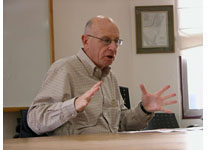|
By Ira Sharkansky
 JERUSALEM—Sometime in the 1980s I spent about an hour with a cup of coffee and Moshe Katsav. I recall thinking that the young Knesset member was bright, engaging, committed, and likely to go far. I also noticed the scar on his face, and thought that growing up in a poor town had prepared him for the politics of a tough country. JERUSALEM—Sometime in the 1980s I spent about an hour with a cup of coffee and Moshe Katsav. I recall thinking that the young Knesset member was bright, engaging, committed, and likely to go far. I also noticed the scar on his face, and thought that growing up in a poor town had prepared him for the politics of a tough country.
After being elected mayor at the age of 24, he served in the Knesset from 1977 to 2000. He did not climb above the levels of Minister of Tourism, Labor and Welfare, and Transportation. On Israel's political pecking order, those positions are not in the upper quadrant of prestige. Yet he beat out Shimon Peres in a Knesset contest to select a president. Peres was 20 years older, had been prime minister and minister of just about everything else, had a Nobel Peace Prize and international renown to go with it. Peres was expecting a majority of the Knesset to vote for him, but too many were tired of his "New Middle East," and expected him to use the ceremonial office for a personal agenda. Katsav had a reputation among insiders as a crude pursuer of office sex. Government secretaries warned newcomers what they could expect. Senior police officers sat on the stories in the absence of formal complaints. One Knesset member told me that some of his colleagues felt that the distinguished office of president would cure Katsav. In any case, the mood was "anyone but Peres." The general public knew no more about the unsavory Katsav than Americans had known about John Kennedy's prostitutes and venereal infections until long after his death.
Two and one-half years ago, Katsav began his own unraveling when he told the Attorney General that one of the women working in the presidential mansion was trying to blackmail him with a story she had fabricated.
Since then, prosecutors have dithered about the charges to be brought. They have questions about the reliability of the women who have lodged complaints, and their capacity to withstand cross examination. They have now decided to file for rape, sexual harassment, and obstruction of justice.
Together with appeals, the case may take several years to reach its conclusion.
Before those procedures even begin, it is appropriate to ask how a successful politician got himself into such a mess. All by himself, Katsav moved from a sullied reputation unknown to the general public to a condition where he has provoked the media and much of the population to declare him guilty.
Katsav's complaint about blackmail was the trigger that led the police to open an investigation. It took them less than a week to take those stories of sexual misconduct off the shelf of rumors and innuendo, and begin exposing the president's current and past behavior. Several women came forward with complaints. A number of them were beyond reach due to statutes of limitation. Procedural rules have kept the public from seeing any full face pictures of the accusers, but they have gone public with stories of inelegant foreplay and unwilling sex. Against them, the former president, members of his family and his attorneys have spoken about women who continued to work for Katsav, and even sent him cordial notes after the events were said to have occurred. Katsav has not admitted to having sex with anyone other than his wife.
The charge of blackmail remains in limbo. The Attorney General has not included that woman's complaints against the president in the indictment being prepared.
If Katsav's complaint about blackmail was the first action that he took to bring his career to an inglorious end, the second action was a press conference that he called to defend himself against a media witch-hunt. The live broadcast and countless replays have shown him with a distorted face, waving in anger, and yelling accusations at the anchor of the prime time news show with the largest audience.
Soon after that news conference, one of the country's most distinguished attorneys, a former minister of justice, resigned from Katsav's defense team.
Katsav suspended himself from the presidency, then resigned shortly before the end of his term. He agreed to a plea bargain that included charges of sexual harassment and indecent acts, a jail sentence that would be suspended, and compensation for two women.
Katsav's third action that worsened his situation came ten months later, when he renounced the plea bargain shortly before it was due to be considered by a district court.
It has taken the Attorney General and his staff almost a year from that time to decide that complaints are reliable enough to support indictments for rape as well as the lesser charges. Their announcement set the stage for what appears to have been Katsav's fourth action of self condemnation. He announced apress conference, accepted a draft from media advisors that would have him speaking for about 20 minutes, and said that he would answer questions. However, he replaced the draft prepared by professionals with his own material that he read for close to three hours. He repeated allegations of being persecuted by a conspiracy of government prosecutors, the media, political and social elites, and false complaints. Television channels stopped their live coverage after an hour or so. Journalists abandoned the
Go to top of next column
|
|
hall. Katsav refused to answer questions. His two media advisors resigned the next morning.
Beyond the humiliation of a president accused of severe crimes is the puzzle of why he has made it worse for himself. He recalls the story of Richard Nixon, who succeeded in turning an embarrassing episode at Watergate into the end of his presidency.
The charges against Katsav are more damning. What is similar is each man's worsening his chances of survival. Nixon escaped the prospect of a trial for lying and other crimes by virtue of Gerald Ford's sweeping pardon.
A wise Katsav, aware of the tinder involved in the charges against him, would have offered his resignation, apologized for misunderstandings or unintended harm, and committed himself to emotional treatment. That would have ended his political career, but could have saved him and his family a great deal of anguish and the prospect of serious jail time. We do not know the source of considerable outlays for a prestigious team of attorneys, other advisors, and their aides.
Why didn't he choose the simple road, rather than repeated displays of angry denial and accusations of conspiracy? I have no convincing answer. He has added the appearance of instability to spreading beliefs that he is guilty of indecency or worse.
There remains the cross examination of testimony that some prosecutors consider to be problematic. But that assumes that Katsav will not continue to immolate himself in public, and that his distinguished lawyers will not follow other professionals who have abandoned him to himself.
Sharkansky is professor emeritus of political science at Hebrew University. His email is msira@mscc.huji.ac.il

San Diego Jewish Academy students win honors
|
|


